New era of thermal insulation
TSM Ceramic.
Liquid ceramic heat insulating coating
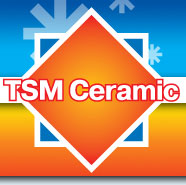
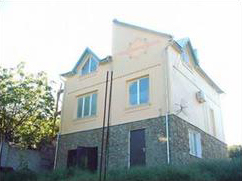

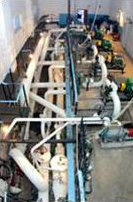

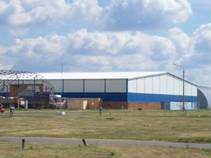
TSM Ceramic - a new era of thermal insulation materials
So our body is arranged, which can live, create and multiply only in comfortable conditions for him. After the question "Where to get food?", Human has always been interested in the second question: "How to warm up or where to find coolness?"
Lovely homes are being built, various are developed and produced heating systems and air conditioning systems, the mass of thermal insulation materials for the "trim", "loose", "plugging" to save heat in your apartments, save it in feed pipelines, in various mechanisms and aggregates, or protect against excessively high temperatures.
All this is wonderful, but the heat saving by traditional materials and methods requires considerable costs of funds, time, forces for installation and repair. In most cases, the development of special construction structures of thermal insulation, which additionally take time, money and space itself to install these structures are necessary. This is all familiar and owners of dwellings, and workers of thermal networks, enterprises, factories, everyone who faces the issue of saving heat or isolation from it.
For a long time, modern science did not pay serious attention to thermal insulating materials, but finally came and their time.
The development of a new thermal insulation material began in USA research institutes, Germany and Japan more than 30 years ago and practically turned over the ordinary idea of \u200b\u200bthermal insulation materials. Bring out, in fact simultaneously in different countries, to find a new solution of thermal insulation material forced the problems of thermal insulation of space ships and orbital stations. It was necessary to be reasonably a new approach to the problem of insulation of heat fluxes, as existing materials, as if not to upgrade them, it was impossible to achieve the required qualities. We needed a material with minimal weight, minimum thermal conductivity, which ensures the creation of a solid coating on complex surfaces and occupying a minimum of space.
The problem of solving the problem was unanimously the basic principles of heat insulation - the reflection of the heat flux and the decrease in the thermal conductivity of the coating. And the best heat-known heat insulators, of course, a vacuum in a mirror shell, a well-known simple thermos.
Based on these long-known facts, a fundamentally new type of thermal insulation was invented - a liquid ceramic heat insulating coating (gastrointestinal tract), which is characterized by known heat insulators and the type, and the principle of work, and the highest performance indicators. In this material is reasonable, within modern science, compromise the properties of the heat flux, "stop" of its passage and some "locking" in the mass of the insulator itself.
And all these properties are enclosed in a liquid that is applied as paint, on any surfaces, including hot to 2000s and more degrees, and after drying, the insulating coating additionally has both waterproof properties, elasticity, sufficient strength and unprecedented durability. Although this material was invented for the needs of NASA to ensure the thermal insulation of orbital complexes, it from the end of the 90s of the last century is used in the civilian sphere, where has already proved its unique opportunities
A complete explanation of the principle of operation of the gastrointestinal tract is quite difficult, it is provided in the special literature. We will try very briefly: the unique ability of the GTS is ensured by the fact that hollow microscopic (0.03 - 0.08 mm) hollow ceramic balls with cut air and silicone balls filled with air are introduced into a specially created synthetic liquid rubber. The coating is applied in several very thin (0.06 - 0.6 mm) layers. The heat flux entering, cold or hot, is revealed first from the surface of the first layer, then the promotion is "slowed down" with hollow balls, the reflection of the flow remains from the next layer and the "deceleration" of the balls is repeated. In this case, such an interesting phenomenon occurs as the holding of the heat flux in the coating layer itself, which is why the surface temperature of the coating measured, for example, a pyrometer turns out to be actually significantly lower.
One of the best such unique materials we offer you - TSM-CERAMIC (TSM-Ceramics) of Info Vit, manufactured by the Ukrainian plant based on imported components on American technology.
Briefly about TSM CERAMIC
- This is a viscous light water-soluble liquid odorless white color With the possibility of toning. After drying and polymerization, the coating becomes water-soluble, stretchable, elastic, dense.
- Applied to the surface like paint - with an airless sprayer or brush.
- The thickness of one coating layer is only 0.4 - 0.6 mm,
- No special designs for fastening, no "abduction" of space!
- Polymerization period 12 hours at room temperature.
- Full drying - 24 hours.
- Perfectly lies with a solid layer on the surface of any form: metal, concrete, brick, wooden, plastic, rubber, cardboard and some others.
- Protects from moisture and corrosion of metal.
- There is no smell, it is environmentally friendly harmless to both the health of people and animals and all of nature.
- It has high fireproof - charring occurs at temperatures about + 5000s, and at temperatures above 8000c decomposes on carbon monoxide and nitrogen, the pairs of which prevent the flame spread!
- The temperature of the surface coated can be from +5 0 to +150 0 ° C.
- The material is operated at temperatures from - 47 0 to +260 0 ° C.
- The rate of consumption of material with a single-layer coating, recommended by a thickness of about 0.5 mm, 1 liter by 2 m2.
- Service life before overhaul - more than 20 years
TSM CERAMIC layer effective:
- Polystyrene - 16 times,
- Minvati - 19 times,
- Foam concrete - 60 times.
Main applications of TSM Ceramic
Building:
- The drowning of walls, ceilings, floors and roofs of a wide variety of buildings and buildings, both with internal and outside.
- Elimination of condensate formation on walls, pipelines, on the inner surface of the roofs, etc.
- Protection against temperature fluctuations (both from heat and cold) elevators, freezers, indoors of livestock and poultry complexes, various structures for storing and maintaining equipment, materials, etc.
- Processing of the designs of the lifting mechanisms and the lower parts of the bridges to reduce the freezing.
Heat and power:
- Pipelines for transporting hot and cold liquids and gas.
- Hydrants, heat exchangers, boilers, steam boilers, pipe fittings.
- Underground and terrestrial oil pipelines.
- Capacities for storing and transporting water, petroleum products, chemicals.
- Refrigerators.
Transport:
- Internal surfaces of the enclosures, cabins and motor compartments of all types vehicle.
- Refrigerators.
- Automotive and railway tanks for liquids and gas.
- Fuselage of aircraft.
The use of TSM Ceramic gives you saving space, time and money.
The insulation repair is reduced to a simple restoration of the coating with a brush or spraying: no complicated disassembly of structures, no dismantling, utilization of old isolation and no preparatory work, No stopping of hot aggregates to reduce temperature, as the coating can be applied to hot surfaces.
The heat energy is saved, the costs of fuel, electricity, materials are reduced to maintain its necessary parameters, the comfort of work increases.
At the expense of a significant service life of TSM Ceramic coverage, the total costs of repair and restoration work are reduced, in comparison with operational expenses for standard isolation.
Some examples:
Brick building facade insulation

Insulation inland walls

Insulation hangars insulation of industrial equipment


Principle of action of material
At the heart of the unique capabilities of the thermal insulation material TSM Ceramic lying microscopic (0.03-0.08 mm) balls, hollow ceramic and air filled silicone. Bulbs in suspended state are in a liquid synthetic rubbing and have the ability to be heated and cool. In a liquid state, this white suspension, which, after drying, creates an elastic coating.
The coefficient of thermal conductivity of the material at a temperature of + 200 ° C is not more than 0.001 w / (m · k), therefore, for the necessary heating resistance, the layer thickness may be very insignificant.
The reflection force of the thermal flow of the TSM CERAMIC material is 60-70%, it means that the heat returns back to the room.
As is known, the heat transfer process in nature is carried out by several physical phenomena - thermal conductivity of the body itself, convective heat exchange and radiation radiation. Therefore, the resulting thermal conductivity of any physical body Determined as the sum of these three components:
TSM Ceramic is a capillary-porous body, differing from traditional heat-insulating materials by the fact that the interpore space is in a state of discharge.
The permitting of the interporespace, which is in the ceramic spheres, significantly reduces the convective component of the heat transfer this material.
In addition, due to the high reflection coefficient of ceramic spheres, radiation (radiant), the heat transfer component is also many times less than in traditional heat-insulating materials.
Therefore, the resulting (effective) thermal conductivity of TSM Ceramic is very small, which allows the material to have a very high thermal insulating efficiency.
For comparison: TSM Ceramic coating is approximately 1 mm thick, it provides the same effective thermal insulation as a layer of stone wool in 50 mm.
Heat flow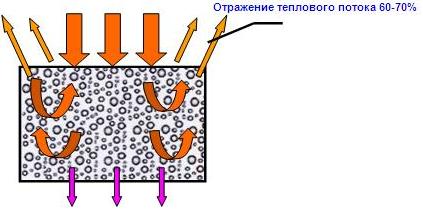
The high reflectivity of the TSM Ceramic material is due to the high reflectivity of discharged ceramic and silicone spheres.
Spheres of spheres significantly reduces the effective thermal conductivity of the TSM Ceramic material compared with materials that the density of the same order.
TSM Ceramic. You can apply to the surface of almost any form and in hard-to-reach places. It has a very good clutch with the treated surface, and it can be boldly apply to metal, concrete, brick, wood, plastic, rubber, cardboard and other surfaces.
The temperature of the surface on which the material is impeded can be from +1 to + 150 ° C.
Permissible temperature during operation - from -47 to + 260 ° C. Unlike other thermal insulation materials, TSM Ceramic protects both corrosion and dampness.
Additional properties TSM Ceramic
TSM Ceramic - anti-corrosion material.
TSM CERAMIC has a high adhesion indicator, which allows you to insulate the surface of water and air access, thereby eliminating the potential of external corrosion and rust formation, in contrast to the "wrapping heat insulators", polyurethane foam or mineral wool.
TSM Ceramic - Fireproof material and insulating material that does not support burning.
The film with a thickness of 1.0 mm is only charred at a temperature of 500 ° C and decomposed at a temperature of 840 ° C, highlighting carbon monoxide and nitrogen, which contributes to the slowdown in the spread of the flame.
The material complies with fire safety requirements, has the conclusions of fire laboratories:
- the combustible group - P according to GOST 30244-94 (low bowls on SNIP B.V. 2.7.-19-25 *),
- group of flammability - VP according to GOST 30402-96 (flammable on SNIP B.V.1.1.-2-97 *),
- by the spread of the flame - moderately spreading the flame DSTU B.V.2.7.-10-98.
TSM Ceramic is an environmentally friendly material.
TSM Ceramic does not contain toxic or harmful substances in its composition, which allows you to work with it in rooms without additional ventilation.
TECHNICAL SPECIFICATIONS TSM CERAMIC
|
Name |
Unit |
Value |
Notes |
| Thermal conductivity at 20 ° C, no more | GOST 7076-87 | ||
| Density in dry | GOST 17177-94 | ||
| Density in liquid form | GOST 17177-94 | ||
| Parry permeability coefficient | GOST 25989-83 | ||
| Specific heat |
kJ / kg ° C |
||
| Heat resistance at a temperature of 260 ° C | Lack of cracks, bloat and bundles | ||
| Water absorption | GOST 11529-86 | ||
| Relative lengthening at break, not less | GOST 11262-80 | ||
| Relative lengthening with an accelerated aging (10 years), not less | GOST 11262-80 | ||
| Linear elongation | GOST 11262-80 | ||
| Clutch strength during separation, not less - with metal - with concrete - with a tree |
1,53 |
GOST 15140-78 | |
| Tensile strength, not less: - After applying - After accelerated aging (10 years) |
GOST 11262-80 | ||
| Structural strength | GOST 4765-73 | ||
| White% diffuse reflection - After applying -after 10 years |
GOST 896-69 | ||
| Transportation and Storage Temperature | |||
| Surface temperature when applying material |
from + 1 to +150 |
||
| Operating temperature |
from -47 to +260 |
||
Thermophysical properties of TSM CERAMIC material
As a result, those million expenses that were spent in different countries to create a fundamentally new heat insulator successfully pay for huge amounts of cost savings when using TSM-Ceramic in various fields:
- Reducing labor costs and time when using TSM Ceramic due to the ease and ease of working with the material.
- Reducing the cost of repairs after the expiration of the warranty period due to the absence of the need to dismantle the old isolation.
- Reducing the cost of saving thermal energy in pipelines, steam boilers, etc. Due to high thermal insulation characteristics TSM CERAMIC and full insulation of pipelines, steam boilers, etc., even in the most hard-to-reach places.
- Reducing energy consumption for ensuring the required thermal regimes of refrigeration plants, various rooms, storage tanks and transportation of liquid, gaseous and solid products.
- Reducing the weight of vehicles and an increase in their internal free area when using TSM Ceramic.
- Due to the lightness and strength of the TSM Ceramic, the thermal protection of complex loaded structures from metal and concrete without the need to further enhance them and develop special measures to preserve the strength characteristics of such structures.
- The ability to apply TSM CERAMIC directly to a hot surface, without stopping the operation of this heat network or steam boiler.
- Reducing the cost of installation of thermal insulation by reducing technological operations related to insulation of pipelines, etc. When using TSM Ceramic as an insulation.
- Competitive price of TSM CERAMIC material in comparison with commonly used isolations.
Advantages of TSM Ceramic in comparison with standard thermal insulation materials
|
Name |
Standard |
Material |
|
|
Cost of materials |
|||
|
Labor intensity of performance |
|||
|
Seasonality of work |
Not lower + 70s |
||
|
Environmental Safety |
|||
|
Aesthetics |
|||
|
Corrosion Pipe Resistance under heat insulation |
|||
|
Durability |
|||
|
Application in hard-to-reach places |
|||
|
Moisture resistance |
|||
|
Warranty period |
|||
|
Repair costs |
|||
|
Environmental Safety |
Great to health |
Not dangerous |
|
|
Physical properties |
Loss of properties under the influence of atmospheric precipitation |
Waterproof, racks to corrosion, does not lose properties |
|
|
Foreign safety |
Fire hazard, toxic substance |
Fireproof |
|
|
Transport costs |
|||
|
The need to stop the production cycle when performing work on thermal insulation |
With the stop of the production cycle |
Without stopping the production cycle |
|
|
Criminality |
Represents interest for recycling |
Does not represent interest for recycling |
|
|
coefficient of heat transfer |
record low |
"-" limitations; "+" Advantages.
The material has certificates and hygienic conclusions of Latvia, Russia, Ukraine.

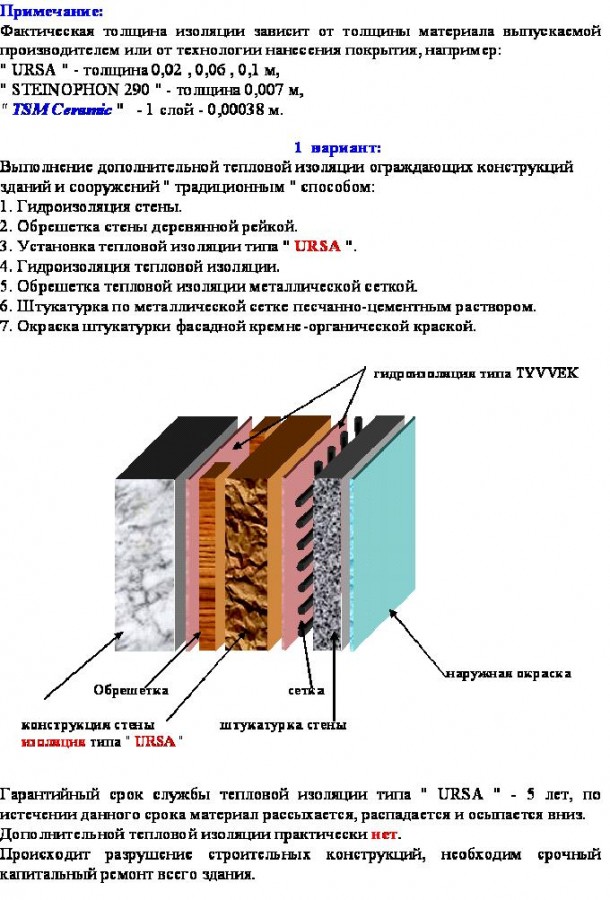

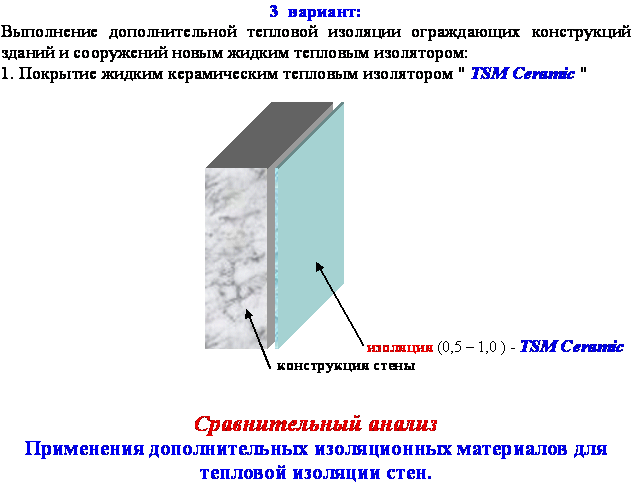
|
Name |
Units. change |
"URSA" |
"Steinophon" |
|
| Thermal conductivity | ||||
|
Warranty period |
||||
|
Overhaul |
required |
required |
Not required |
|
|
Additional construction events |
Eliminating the effect of "dew point" |
Not required |
||
|
Hygienic |
Great to health |
non-toxic |
non-toxic |
|
|
Criminality |
Prone to plunder |
Does not represent interest for reuse |
||
|
Physical properties |
The material loses its properties under the action of atmospheric precipitation and time |
Does not lose properties |
Does not lose properties |
|
|
Technical solutions |
Need verification carrier ability foundation |
Extra weight on the foundation no |
||
|
Architecture |
Additional architectural solution for the facade |
Retains all architectural forms |
||
|
Methods of application |
Only outside and only for walls |
Both outside and inside the building. Walls, floor, roof |
||
Examples of coverage
Heat and power
Currently, for thermal insulation of various pipelines and containers for storing all sorts of chemicals, materials such as polyurethane foam, penity, an avo, mineral wool are used. This method of insulation of pipelines not only pollutes the environment, but also is dangerous to human health. In addition, the warranty period of such materials is not great. Almost, after 1 to 2 years, under the influence of atmospheric precipitation and temperature drops, standard thermal insulation coatings completely lose their heat-insulating properties, peeling, shuffling on the ground.
Insulation: polyurethane foam and mineral wool.

Cellular water pipelines 2 years after applying a standard thermal insulation coating on it.
Unlike the well-known thermal insulation materials, TSM Ceramic has perfectly proven itself as thermal protection of structures with high temperatures.
The ability of TSM Ceramic to work with high temperatures, good adhesion, virtually any material, makes it indispensable for use as a heat and waterproofing coating in thermal power. In addition, the ability to apply the TSM Ceramic sprayer or tassel on the surface of a complex configuration, allows you to use the material in the most hard-to-reach places.
Unlike "wrapping isolations", TSM Ceramic can be preserved not removed rust and eliminates the possibility of forming corrosion on the surface coated.
Application:
- Air conditioning systems
- Pipelines for pumping oxygen,
- Pipelines of heat heating systems,
- Hot and cold water pipes (to prevent condensation),
- Heat exchangers,
- Water heaters,
- Hot chemical mixing tanks,
- Capacities and water storage tanks, nitrogen, gasoline, chemicals,
- Steam boilers
- Underground, terrestrial oil pipelines
- PARTROSTRUES,
- Gas pipelines,
- Boilers
- Refrigerators,
- Hydrants, etc.


Pipelines of heat water (150-700C). Temperature on the surface 350c.


Pipelines and thermal immature of the thermal point (95-700C). Temperature on the insulation surface + 350c. The room temperature dropped to 100 ° C.


Capacities for storing liquid chemicals. The required storage temperature is provided.
![]()

Pipelines of the boiler station. Temperature of heat water 1500С, temperature on the insulation surface + 400c
Comparative table of thermal losses when used on pipelines with heat-watering water for insulation of mineral wool and TSM CERAMIC material.
|
Ambient temperature |
Temperature coolant |
Mineral wool |
TSM Ceramic. |
|||
|
Thickness isolation |
Thermal losses on 1m2 pipero- water (Kcal / m2ch) |
Thickness isolation |
Thermal losses on 1m2Trupprofrovod
|
Required amount of material on 1 m2trub (liter) |
||
Comparative table of thermal losses
when used on pipelines with heat and heat insulation of mineral wool and TSM CERAMIC material at minus temperatures.
|
TemperaturerA of the Environment 0s |
Tour Tour Hairless Tel 0s |
Mineral wool |
TSM Ceramic. |
|||
|
Thickon the Isol (mm) |
Thermal losses on 1m2 pipe pipe (Kcal / m2ch) |
Thickness insulation (mm) |
Thermal losses on 1m2 pipe pipe
|
Needless amount of material for 1 m2 pipe (liter) |
||
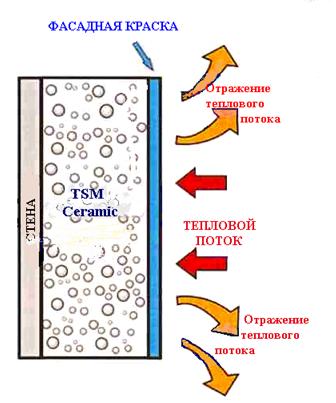
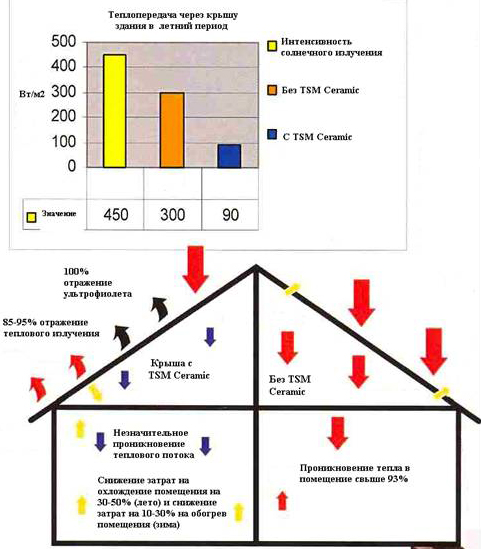

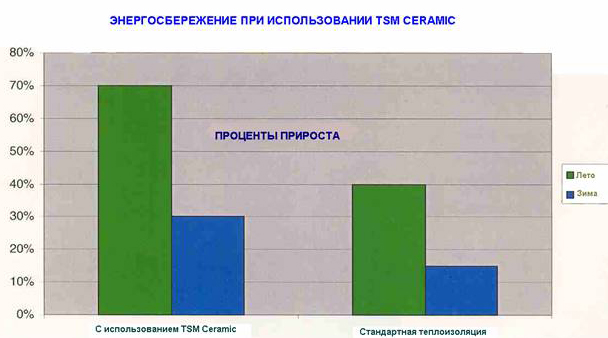
Comparative insulation table with liquid ceramic heat insulating material TSM Ceramic and galvanized steel on mineral wool mats per 100 m2.
|
|
TSM Ceramic. |
Do \u003d 159. |
Do \u003d 325. |
Do \u003d 630. |
Do \u003d 820. |
|
|
Cleaning metal surfaces brushes |
||||||
|
Dusting metal surfaces |
||||||
|
Degreasing surfaces of pipelines solvent No. 646 |
||||||
|
Obunting of metal surfaces at one time by TCM |
||||||
|
The coating of the engineered surfaces with TCM material, 1 mm thick |
||||||
|
Metal surface etchophosphoric acid |
||||||
|
Coloring of metallic engineering surfaces with composition OS-51-03 in 4 layers |
||||||
|
Isolation of pipelines Mats mineral wool firmware, 60 mm thick |
||||||
|
Coating surfaces of pipelines galvanized steel 0.8 mm |
||||||
|
And Togo |
||||||
|
And that with VAT |

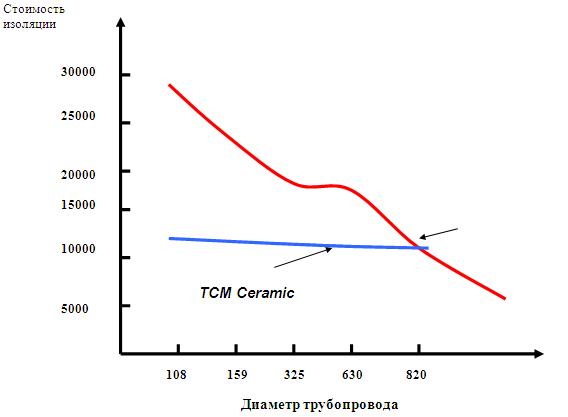
1. High resistant to atmospheric precipitation, to temperature drops and to the effects of solar radiation 2. Record low thermal conductivity coefficient (0.001 W / (M ° C) - 0.0016 W / (M ° C)) 3. Durable - warranty period of 10 years , Over 30 years of service 4. High degree of adhesion 5. Put anti-corrosion properties, waterproof 6. Operating temperature from -60 ° C to + 260 ° C 7. Resistant to mechanical damage 8. Ability to use isolation on objects with complex configuration 9. Absolutely environmentally friendly and fireproof material 10. The cost and timing of work on application is significantly less compared with traditional thermal insulation
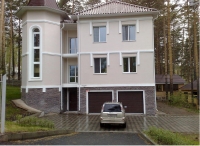
TCM ceramics has a low vapor permeability ratio. Therefore, consider whether it will not impede the diffusion of the wagist vaporization from the wall thickness, because Parry permeation resistance should decrease on the inner layer of the multilayer design to the outer. We will make simple calculations: TSM ceramics-μtsm \u003d 0.0014 mg / m × h × Parium permeability panel; Brick - μk \u003d 0.11 mg / m × h × vapor permeability panel; Mesh concrete (type "Sibit") μs \u003d 0.17mg / m × h × pa - parry permeability coefficient; but) brick wall thickness ΔK \u003d 0.51 m isolated Δtsm \u003d 0.0025 m \u003d 2.5 mm \u003d 0,51 / 0.11 \u003d 4.6 m2 × p / mg \u003d 0,51 / 0.11 \u003d 4.6 m2 × × μl; Rtsm \u003d Δtsm / μtsm \u003d 0.0025 / 0.0014 \u003d 1.8 m2 × h × pa / mg; The conditions are observed b) a wall from a cellular concrete (type "Sibit") is isolated to the Δtsm \u003d 0.0015m \u003d 1.5 mm thick ceramics with a thickness of the CSM. RSIB. \u003d ΔC / μS \u003d 0.4 / 0.17 \u003d 2.35 m2 × h × pa / mg; Rtsm \u003d Δtsm / μtsm \u003d 0.0015 / 0.0014 \u003d 1.07 m2 × h × pa / mg; The conditions are observed.

TCM ceramics is used in construction not only as a heat insulating coating, but also as a waterproofer. The presence in the latex material provides him with low water absorption capacity. The possibility of using TSM Ceramic as protection against the formation of condensate in the premises, allows not only to eliminate the freezing of walls, but also get rid of fungal formations and mold. When calculating the thermal resistance of the enclosing structures of buildings, the following formula is used: RS \u003d 1 / άVN. + ΔT. / λst. + ΔIs. / λiz. + 1 / άN., Where RR. - required by SNIP-AM resistance of the enclosing structure (W / (m ° C); ΔT. - Wall thickness (M); λT. - the thermal conductivity coefficient of the wall (W / (M ° C); ΔI. - TSM CERAMIC insulation thickness ( m); λiz. \u003d 0.001 - the thermal conductivity coefficient TSM CERAMIC (W / (M ° C); άVN. \u003d 8.7-heat transfer coefficient of the inner surface of the enclosing structure (W / (M ° C). It is accepted by SNiP in engineering calculations For any inner surface. άN \u003d 23-heat transfer coefficient of the outer surface of the enclosing structure (W / (M ° C). It is accepted by SNiP in engineering calculations for any outer surface. In liquid ceramic thermal insulation coatings, including TSM ceramics, coefficients The heat transfer is much lower than those adopted SNIP-OM 8.7 and 23 units. So άtsm (H) \u003d 2.2 units with external application and άTSM (B) \u003d 1.67 units with internal application. Thus, with engineering calculations with a classic insulation Its thermal resistance is calculated: RIP. \u003d ΔIZOL. / λizol., Because in calculations Thermal resistance RV. and RN, respectively, 8.7 and 23 units remain unchanged. When using TSM ceramics, for example, on the outer surface of the enclosing structure, with άtsm \u003d 2.2 units, the thermal resistance of this surface will be RN \u003d 1 / 2.2 \u003d 0.45 units (in engineering calculations SNIP-AM-0.04 Units) Consequently, the additional thermal resistance of the thermal insulation TCM will be: - with an external application: RTSM \u003d ΔTSM / λTSM + (1 / άTSM - 1 / άN) \u003d ΔTSM / 0.001 + (1 / 2.2-1 / 23) ΔTSM \u003d 0.001 × (RTSM - 0.41). - with internal application: rtsm \u003d Δtsm / λtsm + (1 / άtsm - 1 / άV) \u003d Δtsm / 0.002 + (1 / 1.67-1 / 8.7) Δtsm \u003d 0.001 × (rtsm - 0.48). From the practice of using the material, the following indicators of thermal conductivity and heat transfer coefficients are recommended in construction in construction: λtsm \u003d 0.001 - the thermal conductivity coefficient TSM CERAMIC (W / (M ° C); άV \u003d 1.67 - TSM Ceramic heat transfer coefficient with internal applies (W / ( M ° C); άn \u003d 2,2-coefficient TSM Ceramic heat transfer coefficient at outer application (W / (M С); recommended application thickness - from 0.4 to 3.5 mm.

The calculated formulas for a flat wall is much easier for the formulas for cylindrical objects. Usually, the formulas for a flat wall can be used if the diameter of the insulated wall is more than 200 mm. The thickness of the insulation TCM ceramics changes in the range of 4.5-3.5 mm, consequently, when the CEMM is copyright, the formula for calculating the flat walls is used on cylindrical objects. Thus, the calculation of the thickness of the heat-insulating coating of TCM ceramics on the hot surface is carried out according to the SP 41-103-2000 according to the following form: ΔTSM \u003d λTSM (TN-T0) / άTSM (1,2) (TN - then); Q \u003d άTSM (1,2) (TN - T0), or Q \u003d (TN - T0) / (1 / άV + 1 / άTSM (1,2) + ΔTr. / ΛTr.), Where ΔTSM is the thickness of the insulation TCM Ceramics (mm); λtsm \u003d 0.001 - thermal conductivity coefficient TSM CERAMIC (W / (M ° C); άtsm-1 \u003d 1,29 - heat transfer coefficient TSM ceramics when applying indoor material (W / (M ° C); άTSM-2 \u003d 2.2 - The heat transfer coefficient TSM ceramics when applying the material in the open air (W / (M ° C); TN - the temperature of the carrier (° C); Tn - the surface of the surface after applying ceramics by sanitary and hygienic requirements (° C); T0 - temperature Environment (° C); q -provy losses per m² insulated TCM surface ceramics (W); when calculating the thickness of the coating on objects inside the ambient temperature of the environment Take + 18 ° C ÷ + 20 ° C. When calculating the thickness of the coating On open-air objects, the value of the ambient temperature is to make an average annual temperature of this region.

Properties of material "TCM ceramics"
The thinnest insulation (1.0 - 3.0 mm) prevents the formation of corrosion waterproils the surface eliminates the formation of condensate, mold and fungus has a good steam-perception (breathing) eco- and fireproof is operated at temperatures from - 60 ° C to +260 ° C has a sample Over 30 years old
TSM Ceramic is an innovative liquid insulation, which is issued by the Siberian Heating Saberving Company limited liability company, founded in 2004.This material contains in its composition a plurality of empty particles from ceramics, which are mixed with a binder made on the basis of acrylic, artificial rubber and coloring pigments.
The components listed above give the material lightness and elasticity. After applying, the insulator does not crack from temperature fluctuations and a constructive shrinkage of certain designs.
In addition, insulating paint is characterized by high adhesive properties. It is perfectly applied to any surface, regardless of its shape and manufacturing material.
Scope of application insulation
Liquid ceramic thermal insulation composition can be used to protect the structures of complex shape or processing surfaces in hard-to-reach places.It is great for applying such materials:
- concrete and brick walls;
- wooden and plastic surfaces;
- rubber and cardboard details.
The thickness of the heat insulator layer is not more than 0.6 mm. Complete time drying - from 12 to 24 hours. At the same time, high-quality coverage is formed, the guaranteed life of which exceeds 20 years.
Features of the thermal insulator TSM CERAMIC
The material produced by LLC STK, in addition to the low thermal conductivity coefficient, has several additional properties:- Anti-corrosion. Due to the fact that the composition is well applied and sticks to any surface, it overlaps the access of water and air to the details processed. This eliminates the factors leading to the so-called external corrosion, which cannot be achieved using traditional glass gamble or basalt mats.
- Ecology. In the process of production of the TSM Ceramic insulation, harmful substances are not used, which cause harm environment or man's health. The paint can be applied and operated in rooms that are not equipped with forced exhaust ventilation.
- Foreign safety. Ceramic liquid thermal insulator does not ignite and does not support combustion. At a certain temperature begins to melt, highlighting carbon dioxide, which helps to cope with the fire.
Waterproofing and decorative qualities
The material has not only thermal insulation, but also hydrophobic qualities. This is achieved by adding latex heat insulating paint, so that it does not absorb water. Its use of indoors prevents the formation of condensed moisture, prevents the appearance of fungus and mold, and also avoids the freezing of wall structures during the cold season.In addition, in a ceramic heat insulator, you can add coloring pigment of any color, which will not affect its efficiency. The facades of buildings painted with TSM Ceramic paint do not require additional decorative trim.
Another advantage of production LLC "STK" is an affordable price, which will have a positive effect on the estimated cost of construction.
TSM Ceramic is a liquid thermal insulation coating of microscopic ceramic (filled with air balls, which are in the form of a suspension in the composition of the latex mixture with acrylic polymers).
ATTENTION: Fight freezing !!!
Insulation works can be carried out on surfaces with a temperature of from + 7 ° C to + 150 ° C. The temperature of transportation and storage of the material is not lower than +5 degrees S.
1. Preparation of insulating coating
TSM Ceramic - does not require special training, immediately before applying it must be mixed thoroughly.1.1 Circuit with a knife cover in the places indicated on it. Remove the cover with a 5-gallon bucket - (18., 925) liters.
1.2 Destroy the resulting crust, carefully immersing and lifting a flat spatula in the center and along the walls of the bucket so that the liquid covered the crust.
1.3 Continuing the vertical movements of the blade, immerse the thickening part of the material into the liquid, turn on the drill with the nozzle for mixing, and slowly start mixing the contents of the bucket, mixing bunches with the liquid (so that the bucket does not rotate, hold it with the feet and knees).
1.4 Stirring to continue until the crust is completely dissolved and uniform, "creamy" mass, without clots and lumps.
1.5 Pour a mixed product into a clean bucket through a filter and the diameter of the holes of the mesh (0.5-1.0 mm), the remaining lumps remove so that the sprayer does not drive.
1.6 The thickness of the application of one layer TSM Ceramic is not more than 0.4 mm. In case of multi-layer application, dry each previous layer at least 4 hours at a temperature of 20 ° C.
ATTENTION!
TSM Ceramic does not paint, but an insulating coating. Do not use high speeds when stirring - this will lead to the destruction of ceramic.
When using a drill during stirring, the speed of rotation of the blade should not be above 300 rpm.
2. Preparation of the surface
It lies well on all types of surface: metals, wood, plastic, glass, concrete, brick, etc. The surface should be dry and low-fat.2.1 Insulated surface cleaning from dirt, dust, old paint, rust, etc. (Metal brushes, rags) and degrease (any degreaser).
2.2 Speakers of the metal surface from rust perform with metal brushes with removal of a loose layer of rust, then degrease and let it completely dry the degreaser.
2.3 Concrete and brick surface, before applying TSM Ceramic, clean from dust with a brush and moisten with water.
2.3.1 After dried water, apply one layer of TSM Ceramic primer to the surface, give it to dry for 1st hour, after performing this operation, applying according to claim 1.6.
2.4 From a wooden surface, it is necessary to remove dust and, if possible, resin.
2.5 Plastic surface must be cleaned with shallow skin (to eliminate gloss), remove dust and degrease.
3. Equipment
3.1 TSM Ceramic coating can be applied on the surface with a sprayer, roller or brush.3.2 For applying insulation into small areas Use a soft brush (from pork bristles), a foam brush, a thoroughties of a large diameter with a rigid thin layer of foam rubber, 5 - 10 mm thick, airborne sprayer (compressor with a pressure of no more than 5 - 8 atm, nozzle on a sprayer 0.5 - 0.8 mm).
3.3 To apply insulation to large areas, use a spray gun of an airless type similar to the graco-10,000 sprayer.
4. Preparing the sprayer to work
4.1 Airless Sprayer:Through the sprayer is pre-passed clean water (about 2 liters), then the hose is transferred to the bucket with TSM Ceramic. When the water is over and goes the TSM Ceramic Sprayer to send to the bucket with TSM Ceramic.
For better operation of the sprayer, you need to add to the TSM Ceramic bucket (18,925 l.) 300 gr. Water and mix it thoroughly with the material.
(use nozzle with a diameter of 0.5 - 0.8 mm)
Material and equipment are ready to apply.
The thickness of the material to the surface, without drying the applied layer, not more than 0.4 mm. To apply the subsequent layers, drying the previous ones. (see paragraph 1.6)
5. Applying material
5.1 Before applying the material on any surface, it is necessary to apply a primer layer and give it to dry (at least 1st hour at room temperature).5.2 Preparation of the soil: Dilute 1-H liter of material with 100 gr. Waters, mix the mix thoroughly. When working with the soil, it constantly stirred to prevent lifting the lung material fractions up.
5.3 When working with a tassel or roller, it is necessary to dilute the material with water (on the 1st liter of the material 30 - 50 gr. Waters.
5.4 When working with a brush or roller with material or soil, use only fine dishes (tray under the roller).
Hot surfaces:
5.5 When working with a material on hot surfaces with a temperature of 80 ° C and above, it is used to use a more liquid soil (per 1-liter of the material of 150 gr. Water).
5.6 When working with material on hot surfaces with a temperature above 120 ° C, apply the first 3-layer with liquid soil (on the 1st liter of the material 200-400 gr. Water), let's dry the coating, 4-5 layer - soil (1- N liter of material from 100-150 gr. WATER), after drying the coating, apply the material in proportion, according to claim 5.3.
5.7 Drying time of one layer on hot surfaces is significantly reduced (from 10 min. Up to 0.5 hours).
Attention: For a faster stamping of the material, it is necessary to flip bucket and keep it in an inverted state of 24 hours, after which open and mix according to claim 1.
6. Control of the thickness of the applied coating
6.1 Control of the thickness of the applied coating to perform after its complete drying:- micrometer 0-25 GOST 650788,
- indicator 0.01 GOST 577-88.
7. Safety Requirements
7.1 When working with the material it is necessary to comply with safety requirements according to SNiP 111-4-80, SanPiN 6027A-91, GOST 20010, GOST12,04,013, GOST27575, GOST27574.Our company is engaged in manufacturing and implementing liquid ceramic thermal insulation TSM Ceramic, developed on the basis of aerospace technologies, is intended to obtain a coating with high thermal insulating, waterproofing and anti-corrosion characteristics, applied as paint, acts as thermal protection.
TSM Ceramic. - These are microscopic, hollow ceramic balls that are suspended in a liquid composition consisting of synthetic rubber, acrylic polymers and inorganic pigments. These modern materials make the material light, flexible, stretching. TSM Ceramic has excellent adhesion to the surfaces covered (with a metal - 1.53 MPa, with concrete and a tree - 1.84 MPa), which allows you to insulate the surface-coated surface from access of water and air, thereby eliminating the potential of external corrosion and rust formation in contrast From "wrapping heat insulators", polyurethane foam or mineral wool. TSM Ceramic is a white suspension, which, after drying, forms an elastic coating that performs the role of the "heat mirror". The high reflectivity of the material is due to the high reflectivity of discharged ceramic spheres, which significantly reduces the effective thermal conductivity of the material. Material is capable of reflecting up to 95% ultraviolet and 85% of thermal radiation. The impact results of the salt fog did not reveal the visible changes in the surface, decomposition and corrosion. With the proper applix of the material with a layer of 0.5 mm. Replaces 50 mm. Foam layer. These properties contribute to excellent heat conservation in the case of using the TSM Ceramic material as a heat-insulating wall covering and protecting the roofs when applied to the surface.
The coating of the walls of the premises from the inside makes it possible to maintain heat due to the reflective ability of the material and give them a beautiful appearance, as well as prevents the formation of mold on the "problematic" sections of the flowing walls. In the warm season, due to this, the heating of walls and roofs of buildings, tanks, tanks, pipelines are reduced, which reduces the cost of air conditioning and reducing the evaporation of containers content.
The material is no less efficient to be used for thermal insulation of steam pipelines, hot water, water heating equipment of boiler rooms. The coating also provides sound insulation and prevents moisture condensation on cooled metal surfaces (which prevents their icing in winter and prevents from corrosion). The material is operated at temperatures from - 60 s to + 260 s and has a warranty of 10 years without changing its functional properties, and the service life is over 20 years.
Scope of application
Building:
Walls of residential and industrial buildings, both with internal and outside;
Roofs of residential and industrial buildings, both internal and outside;
Metal roofs;
Metal structures;
Hangars and garages;
The lower part of the bridges (lowers freezing)
Heat and power:
Pipelines of heat heating systems, steam pipelines and gas pipelines;
Pipelines for pumping oxygen, nitrogen, etc.;
Air conditioning systems;
Cold water pipes (to prevent condensation, corrosion protection)
Heat exchangers;
Steam boilers;
Underground and ground oil pipelines;
Hot chemical mixing tanks;
Capacities and water storage tanks, nitrogen, gasoline, chemicals, etc. To protect the content from heating (evaporation) and corrosion prevention
Refrigerators.
Transport:
Covering the inside of the car body, engine compartment, roof;
Coating of the inside of the body of military and special purposes;
Refrigerators;
Automotive and railway tanks for various liquids.
Among the advantages of our material, I also wanted to note that the cost of thermal insulation using TSM Ceramic is significantly lower than the cost traditional systems Heat insulation. The retail price of the material is 350 rubles per liter with VATWholesale price for dealers 270 rubles per liter with VAT.
The material consumption rate with a thickness of the coating is 0.5 mm. Makes 1 liter by 2 m / sq. M. (175 rubles m / kV), work on applying is not laborious. There is a certificate of conformity, a fire certificate (g1), a hygienic certificate (material is not toxic). Material can be transported in a negative temperature to - 5 C.
I hope this information will be useful to you and in demand in your professional activities.
Ready to answer any questions and provide additional information on the material.



